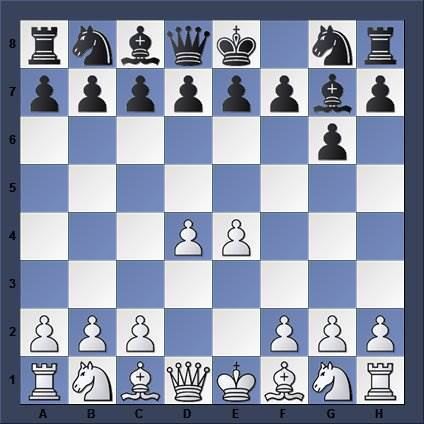a b c d e f | b c d e f g | |
 | ||
Opening school modern defense part 1
The Modern Defense (also known as the Robatsch Defence after Karl Robatsch) is a hypermodern chess opening in which Black allows White to occupy the center with pawns on d4 and e4, then proceeds to attack and undermine this "ideal" center without attempting to occupy it himself. The opening has been most notably used by British grandmasters Nigel Davies and Colin McNab.
Contents
- Opening school modern defense part 1
- Arjun against the modern defense fm aviv friedman 2015 03 17
- Main lines
- 2Nf3
- 2c4
- 2Nc3
- Fischers suggestion 3 h4
- Unusual White responses
- Averbakh System
- Kavalek vs Suttles
- References
The Modern Defense is closely related to the Pirc Defence, the primary difference being that in the Modern, Black delays developing his knight to f6. (The delay of ...Nf6 attacking White's pawn on e4 gives White the option of blunting the g7-bishop with c2–c3.) Transpositional possibilities between the two openings are rife.
The Encyclopaedia of Chess Openings (ECO) classifies the Modern Defense as code B06, while codes B07 to B09 are assigned to the Pirc. The tenth edition of Modern Chess Openings (1965) grouped the Pirc and Robatsch together as the "Pirc–Robatsch Defense".
Arjun against the modern defense fm aviv friedman 2015 03 17
Main lines
A typical move order for the Modern Defense is 1. e4 g6 2. d4 Bg7, with main lines:
2.Nf3
Black can play 2...c5, transposing to the Sicilian Defense, or 2...Bg7.
2.c4
2...Bg7
2.Nc3
Black can play 2...c5 tranposing to a closed Sicilian, or 2...Bg7.
Fischer's suggestion: 3. h4!?
Bobby Fischer suggested the move 3.h4!? as an unorthodox try against 1...g6 2.d4 Bg7, in his annotation to a game against Pal Benko. (Fischer played 3.Nc3 in the actual game.) The idea is to prise open Black's kingside by h4–h5 followed by hxg6 (...gxh5 would greatly weaken the cover to Black's king).
Unusual White responses
The flexibility and toughness of the Modern Defense has provoked some very aggressive responses by White, including the attack crudely named the Monkey's Bum, a typical sequence being 1.e4 g6 2.Bc4 Bg7 3.Qf3. (A more refined version is the Monkey's Bum Deferred, where White plays Bc4 and Qf3 only after developing their queen's knight.)
Other unusual openings can be reached after 1.e4 g6. The Hippopotamus Defence is one such system. Another is the Norwegian Defence (also known as the North Sea Defence) which begins 1.e4 g6 2.d4 Nf6 3.e5 Nh5. (If White plays 4.g4, Black retreats the knight with 4...Ng7. On 4.Be2, Black can retreat the knight or gambit a pawn with 4...d6!? If White plays 3.Nc3 instead of 3.e5, Black can transpose to the Pirc Defence with 3...d6 or continue in unconventional fashion with 3...d5!?)
Averbakh System
The Modern Defense, Averbakh System (ECO code A42) can be reached by the lines:
1.e4 g6 2.d4 Bg7 3.c4 d6 4.Nc31.d4 g6 2.c4 Bg7 3.Nc3 d6 4.e4Possible moves for Black at this point include 4...Nf6, 4...Nc6, 4...e5, and 4...Nd7. The move 4...Nf6 leads to a position of the King's Indian Defence, where White can play moves such as 5.Nf3, 5.f3, 5.Be2, 5.f4, and so on.
Kavalek vs. Suttles
In the following game played at the Nice Olympiad in 1974, Canadian Grandmaster Duncan Suttles, one of the Modern's leading exponents, defeats Czech-American Grandmaster Lubomir Kavalek:
